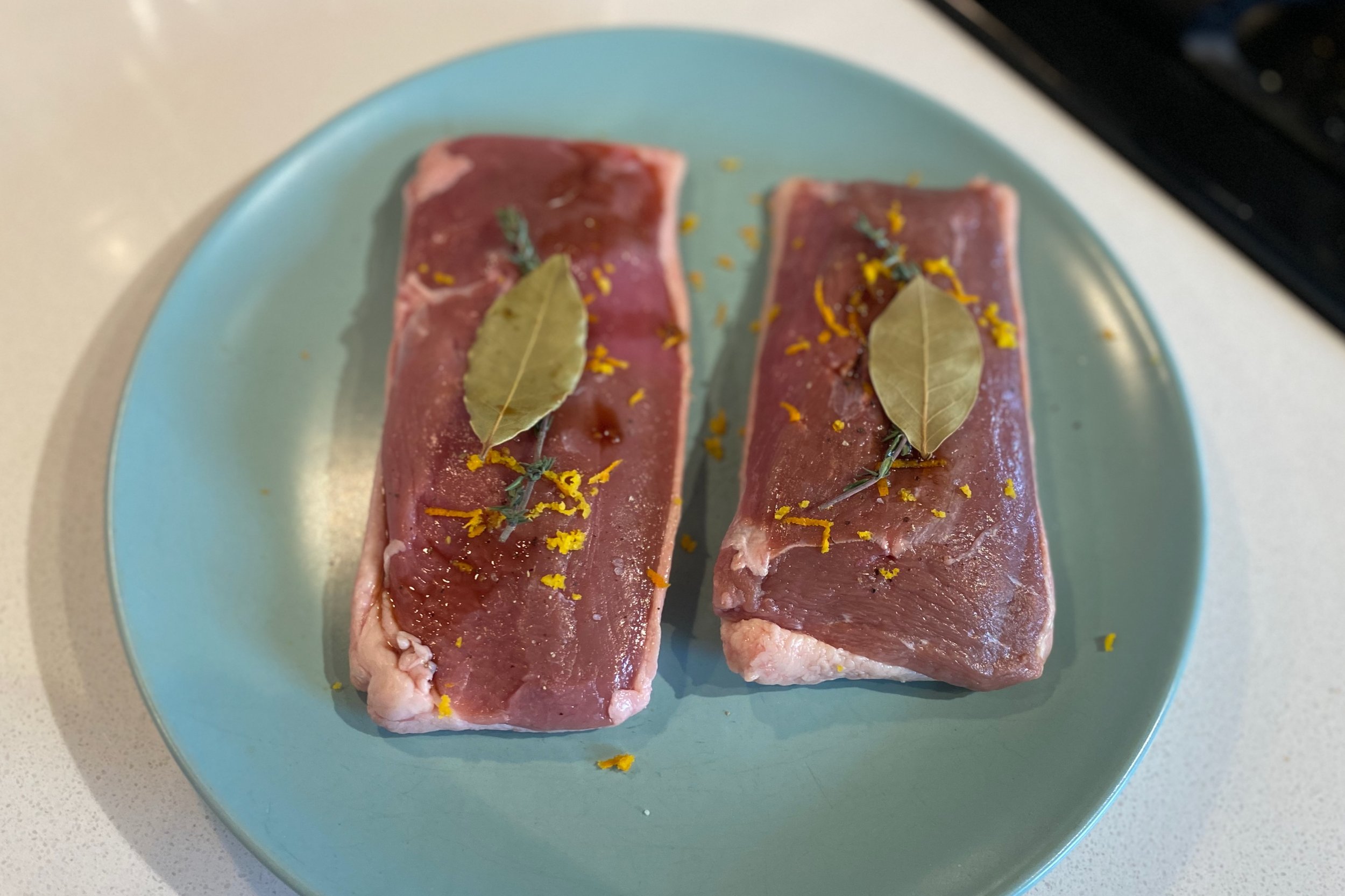Pan-Seared Duck Breast
I’m a huge fan of duck. It’s a great source of protein and iron, easy to prepare and absolutely delicious (it’s also a lot cheaper than you might expect given what most restaurants charge for it).
The key to delicious duck breast is crispy skin, and the key to crispy skin is cooking it low and slow. This recipe — inspired by Chef Thomas Keller’s Ad Hoc at Home cookbook — uses balsamic vinegar, orange zest and nutmeg to add brightness to the natural flavor of the duck.
Pan-Seared Duck Breast
Adapted from Ad Hoc at Home by Thomas Keller.
Serves: 2
Preparation time: 10 minutes (followed by 1 - 12 hours of resting time)
Cooking time: 30 minutes
Ingredients
2 duck breasts
1 orange
2 bay leaves
2 sprigs of thyme
Balsamic Vinegar
Ground nutmeg
Salt and pepper
1 tbsp vegetable oil (for cooking)
Either 1/4 cup of blueberry jam or 1 cup of dry red wine plus 1 tbsp of butter (see Cooking below)
Preparation
(For best results, the duck should be prepped and refrigerated 8 - 12 hours before cooking, so try to do this in the morning before work.)
The first preparation step is to “score” the duck skin. To do this properly, you’ll want to make sure the duck is cold (so remove it from the fridge and score it right away). Use your knife to cut a cross hatch pattern with lines approximately one inch apart. Be careful to only cut the skin and not pierce the flesh underneath (though don’t be surprised if you do the first few times you try this — it’s okay).
Some butchers will score the skin for you
Next, flip the duck breast over. You should notice a tendon running the length of the breast. Use a paring knife to carefully remove the tendon.
Season the flesh side of each duck breast with salt, pepper and a pinch of nutmeg. Grate a small amount of orange zest onto the flesh using a microplane (or the finest setting on a cheese grater, if you don’t have one). Next, sprinkle a few drops of balsamic vinegar onto the flesh. Finally, place one sprig of thyme in the center of the duck breast and cover it with a bay leaf.
Flip the duck breast back over and season the skin side with a generous pinch of salt and a pinch of nutmeg.
Place the duck breasts skin side down on a baking sheet lined with parchment paper and refrigerate uncovered for at least 1 hour and up to 12 hours. This step is crucial, not only because it allows the flavors of the seasoning to penetrate the duck flesh, but because the salt acts to remove moisture from the skin, which is essential to getting nice, crispy skin.
Cooking
Preheat the oven to 300ºF.
In a large, oven-proof pan, heat the oil over medium-low heat. Remove the thyme and bay leaves from the duck breasts, placing the thyme springs in the side of pan so that the duck fat gets infused with the flavor of the thyme.
Place the duck breasts skin side down and sear the skin on low (this is the part that takes some patience). It will take about 20 - 25 minutes to get a nice, crispy skin. Periodically use a small spoon to remove excess duck fat from the pan (make sure to keep this for other uses!). Move the duck breasts around every few minutes to ensure even browning.
Once the skin is nice and brown (see below), flip the duck breasts over and “kiss” the flesh side for about 30 seconds. After that, flip the duck breasts back over so the skin side is down and place the pan in the oven (remove the thyme sprigs before placing the pan in the oven).
Cook the duck breasts for about 5 minutes for medium rare (the internal temperature should be 125ºF).
Remove the duck breasts from the oven and place them skin side down on a cooling rack (it’s really important that you use a cooling rack and not rest them directly on a plate or cutting board — doing so will ensure that any juices that drip off fall through the cooling rack as opposed to pooling and ruining your nice, crispy skin!).
While the duck breast are resting for 5 - 10 minutes, you can choose one of the following finishes:
Warm, blueberry jam
Blueberries and duck is a natural pair. Take 1/2 cup of your favorite blueberry jam and warm it in a small saucepan.
Red wine reduction
Pour any excess fat from the pan you used to cook the duck and pour the red wine into the pan. Increase the temperature to medium high while using a wooden spoon to scrape up any tasty browned bits.
Simmer the wine until it reduces to 1/3 (about 5 minutes). Reduce the temperature and add the butter, along with salt and pepper to taste.
Serving
Slice each duck breast into about 8 slices.
Plate each duck breast, topping either with warm blueberry jam or red wine reduction.
Duck breast pairs with all manner of side dishes, including potatoes, risotto, roasted root vegetables or kale salad.





